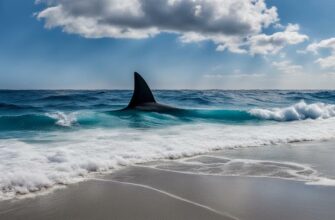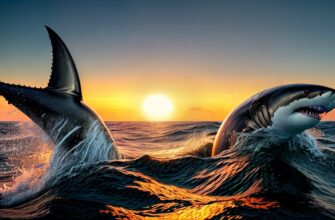Italy is renowned for its delicious food, rich history, and stunning architecture. But did you know that the country is also home to a diverse range of marine life, including sharks?
Exploring the waters of Italy is an unforgettable experience, filled with breathtaking scenery and fascinating aquatic creatures. The Mediterranean Sea, which surrounds Italy, is a hub of marine biodiversity and boasts a wide variety of fish, crustaceans, and mollusks.
- The Mediterranean Sea: A Hub of Marine Biodiversity
- Exploring Italy’s Coastal Waters
- Common Species of Sharks in Italian Waters
- Shark Conservation in Italy
- Shark Sightings and Safety Tips
- General Safety Tips
- Frequently Asked Questions about Sharks in Italy
- Are shark encounters common in Italian waters?
- What types of sharks can be found in Italian waters?
- What should I do if I spot a shark while swimming or surfing?
- How does Italy contribute to shark conservation?
- What are some safety tips for swimming in Italian waters?
The Mediterranean Sea: A Hub of Marine Biodiversity
The Mediterranean Sea is renowned for its rich and unique marine ecosystems, which support an abundance of species that cannot be found anywhere else in the world. Covering an area of approximately 2.5 million square kilometers, the Mediterranean Sea is bordered by Europe, Asia, and Africa, providing a diverse range of habitats for marine life to thrive.
From the shallow, sun-drenched waters of the Adriatic Sea to the deep, dark abyss of the Ionian Sea, the Mediterranean Sea is home to a vast array of ecosystems. These ecosystems are defined by their geography, water temperature, and the amount of sunlight they receive. Some of the most common habitats found in the Mediterranean Sea include seagrass meadows, rocky reefs, and sandy bottoms.
The Mediterranean Sea is home to an estimated 17,000 marine species, with new species being discovered every year. Some of the most iconic marine species found in the Mediterranean include the loggerhead sea turtle, the Atlantic bluefin tuna, and the Mediterranean monk seal. In addition to these well-known species, the Mediterranean Sea is also home to a diverse range of fish, crustaceans, and mollusks.
Exploring Italy’s Coastal Waters
Italy’s coastline stretches for over 7,600 kilometers, and the country’s rich marine biodiversity attracts diving enthusiasts and researchers from around the world. From the northern Ligurian Sea to the southern waters of Sicily, Italy boasts a diverse range of marine species, including fish, crustaceans, and mollusks.
The Mediterranean Sea, which borders Italy to the south, is home to a unique ecosystem that supports a variety of marine life. This includes over 700 species of fish, making it one of the most biodiverse marine regions in the world. Italy’s coastal waters also contain large populations of dolphins, sea turtles, and whales.
| Region | Notable Marine Species |
|---|---|
| Liguria | Octopus, red coral, and groupers |
| Tuscany | Sea bream, lobster, and moray eels |
| Campania | Swordfish, sardines, and anchovies |
| Calabria | Bluefin tuna, swordfish, and amberjacks |
| Sicily | Octopus, squid, and cuttlefish |
The Ligurian Sea, located in the northwestern part of Italy, is known for its unique underwater rock formations and abundant marine life. This includes red coral, a protected species that can be found in the waters off the coast of Portofino.
The Tuscany region, meanwhile, is home to several marine protected areas, including the National Park of the Tuscan Archipelago. Here, visitors can spot a variety of fish species, including sea bream, grouper, and lobster.
The southern regions of Italy, such as Calabria and Sicily, are known for their large populations of bluefin tuna and swordfish. These species have been traditionally caught by local fishermen but are now also heavily regulated to ensure their continued sustainability.
Italy’s marine biodiversity is a key attraction for scuba divers, who can explore the country’s many underwater caves and shipwrecks. However, visitors are reminded to respect marine wildlife and follow conservation guidelines to help protect Italy’s unique marine ecosystems.
Common Species of Sharks in Italian Waters
Italy’s coastal waters are home to a variety of shark species, some of which are commonly found in the Mediterranean Sea. Below are some of the most frequent shark species encountered in Italian waters:
| Common Name | Scientific Name | Length | Habitat | Diet |
|---|---|---|---|---|
| Blue Shark | Prionace glauca | 6-10 feet | Open ocean | Fish, squid, and other small marine animals |
| Thresher Shark | Alopias vulpinus | 10-20 feet | Coastal and open ocean | Fish, squid, and other small marine animals |
| Catshark | Scyliorhinus canicula | 2-3 feet | Rocky areas, coral reefs, and seagrass beds | Fish, crabs, and other small marine animals |
Please note that while these species are commonly found in Italian waters, encounters with sharks are relatively rare and pose little to no threat to humans.
Blue sharks are one of the most frequently encountered shark species in the Mediterranean Sea and are known for their slender bodies and blue-gray coloration. They are highly migratory and can be found in both deep and shallow waters.
Thresher sharks, named for their long, whip-like tail, are known for their acrobatic jumps out of the water. They are typically found in coastal and open ocean waters and are sometimes caught as a game fish.
Catsharks, also known as dogfish, are small, bottom-dwelling sharks that are commonly found in rocky areas, coral reefs, and seagrass beds. They are typically harmless to humans and are often kept as pets in home aquariums.
It is important to note that some shark species found in Italian waters, such as the great white shark, are considered rare or occasional visitors and are unlikely to be encountered by beachgoers or swimmers.
Shark Conservation in Italy
Italy has made significant efforts in recent years to protect sharks and their habitats, recognizing the crucial role they play in maintaining marine biodiversity. The country has established several marine protected areas (MPAs) to safeguard important shark habitats and limit human activities that may disturb or harm these vulnerable species.
One such MPA is the Pelagos Sanctuary, located in the Ligurian Sea and designated for the protection of marine mammals, sea turtles, and sharks. The sanctuary covers an area of approximately 87,500 square kilometers and is jointly managed by Italy, France, and Monaco. It aims to reduce human impacts such as fishing, shipping, and pollution that can harm marine wildlife and their habitats.
Italy also prohibits the catching, trading, and possession of several shark species, including the great white shark, hammerhead shark, and basking shark. These measures are part of Italy’s efforts to enforce the European Union’s shark finning ban and prevent the overexploitation of vulnerable shark populations.
In addition to conservation efforts, Italy also supports shark research to better understand these fascinating creatures and inform management strategies. The Italian Institute for Environmental Protection and Research (ISPRA) conducts regular shark monitoring surveys in the Mediterranean Sea to monitor the abundance and distribution of different shark species. This research is essential for improving our knowledge of these elusive creatures and ensuring their long-term conservation.
Overall, Italy’s conservation efforts demonstrate a commitment to protecting sharks and the marine habitats they inhabit. By establishing MPAs, enforcing regulations, and supporting research, Italy is working to ensure the survival of these magnificent creatures for future generations to appreciate and enjoy.
Shark Sightings and Safety Tips
While sharks are a fascinating part of Italy’s marine life, it’s important to exercise caution when swimming or diving in Italian waters. While shark encounters are rare, it’s always best to take precautions for your safety and the safety of these magnificent creatures.
If you do happen to spot a shark while swimming or diving, the best thing you can do is to remain calm and slowly swim in the direction of the shore. Avoid splashing or making sudden movements, as this can attract the shark’s attention. Remember that most sharks are not interested in humans and will typically swim away if left alone.
It’s also important to be aware of where and when you are swimming. Areas known for their heavy boat traffic should be avoided, as this can increase the likelihood of shark encounters. Additionally, it’s best to avoid swimming during dawn and dusk, as this is when many marine predators are most active.
General Safety Tips
In addition to being mindful of sharks, there are a few general safety tips to keep in mind while enjoying the beaches and waters of Italy:
- Always swim with a buddy or in a group
- Avoid swimming in areas with strong currents or rip tides
- Stay within designated swimming areas
- Wear a life jacket if you’re not a strong swimmer
- Stay hydrated and protect your skin from the sun
Frequently Asked Questions about Sharks in Italy
As sharks can be a source of fascination and fear, they often attract a myriad of questions from curious beachgoers and marine enthusiasts. Below, we address some of the most frequently asked questions about sharks in Italy.
Are shark encounters common in Italian waters?
Shark encounters are extremely rare in Italian waters, and the likelihood of a shark attack is even rarer. While some shark species can be found in Italian coastal waters, they tend to avoid areas with a high human presence.
What types of sharks can be found in Italian waters?
The most common shark species found in Italian waters are the blue shark, thresher shark, and catshark. However, there have been sightings of other species such as the great white, hammerhead, and mako sharks.
What should I do if I spot a shark while swimming or surfing?
If you spot a shark while swimming or surfing, remain calm and avoid any sudden movements. Slowly and calmly move towards shore, keeping your eyes on the shark at all times. If possible, signal to others on shore to notify them of the sighting.
How does Italy contribute to shark conservation?
Italy has taken several steps to protect sharks and their habitats, including the establishment of marine-protected areas and regulations aimed at reducing accidental catch and protecting endangered species. Italy also contributes to international research and conservation initiatives.
What are some safety tips for swimming in Italian waters?
While shark encounters are rare, there are some basic safety tips to keep in mind when swimming in Italian waters. Avoid swimming alone or in areas with a low human presence, as this may attract sharks looking for prey. Additionally, avoid swimming in areas where fishing or hunting is taking place, as this may also attract sharks.









